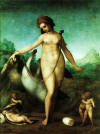Search:: Artists Alphabetically 100 Greatest Painters 50 Greatest Paintings Art Movements
Mannerism Movement
The name mannerism comes from the Italian maniera, which translates to 'style'
Prominent Mannerist Artists
Sofonisba Anguissola(1532
- 1625) Italian,
Florentine
Alessandro Allori
(1535 - 1607) Italian,
Florentine
Agnolo Bronzino
(1503 - 1571) Italian,
Florentine
El Greco (1541 - 1614)
Greek
Giovanni Rosso Fiorentino
(1495 - 1540)
Italian
Juan Fernandez
Navarrete (1526-1579)
Spanish
Pontormo
(1494-1557)
Italian
Parmigianino
(1503-1540)
Italian
Jacopo da Pontormo
(1494 - 1557)
Italian
Paolo Veronese (1528-1588)
Italian
Ventura Salimbeni
(1567-1613)
Italian
Information about the Mannerist Painting Style
Mannerism is an artistic style that surfaced after the Sack of Rome
on May 6 1527, when Charles V, Holy Roman Emperor descended upon Rome
raping, plundering and massacring. Many great artworks were destroyed or
carted off. This senseless slaughter unhinged Renaissance confidence,
humanism and way of thinking to the core. The style originated in Rome
and later widened to all of Europe. Mannerists paintings are
characterized by elongated limbs, thin aquiline noses, overly stylized
figures, undersized heads, electrifying, vibrant colors and elaborately
mannered, theatrical compositions. According to Renaissance scholar John
C. Van Dyke "They produced large, crowded compositions, with a hasty
facility of the brush and striking effects of light. Seeking the grand
they overshot the temperate. Their elegance was affected, their
sentiment forced, their brilliancy superficial glitter. When they
thought to be ideal they lost themselves in incomprehensible allegories;
when they thought to be real they grew prosaic in detail. These men are
known in art history as the Mannerists, and the men whose works they
imitated were chiefly
Raphael,
Michaelangelo, and Correggio. "
The Mannerists in Italy worked on generous commission for a restricted
audience of Vatican powerbrokers and royalty. The subjects they were
allowed to portray was controlled and restricted to biblical themes,
portraiture and occasionally mythology.
El Greco said to hell with the
money went off to Spain to pursue his own amazing vision.
Require more facts and information about Important Mannerist Artists? Poke around every nook and cranny of the known universe for information this subject. Search Here
© HistoryofPainters.com If you like this page and wish to share it, you are welcome to link to it, with our thanks.
If you feel you have worthwhile information you would like to contribute we would love to hear from you. We collect essential biographical information and artist quotes from folks all over the globe and appreciate your participation. When submitting please, if possible, site the source and provide English translation. Email to millardmulch@gmail.com
copyright 2011 - historyofpainters.com
